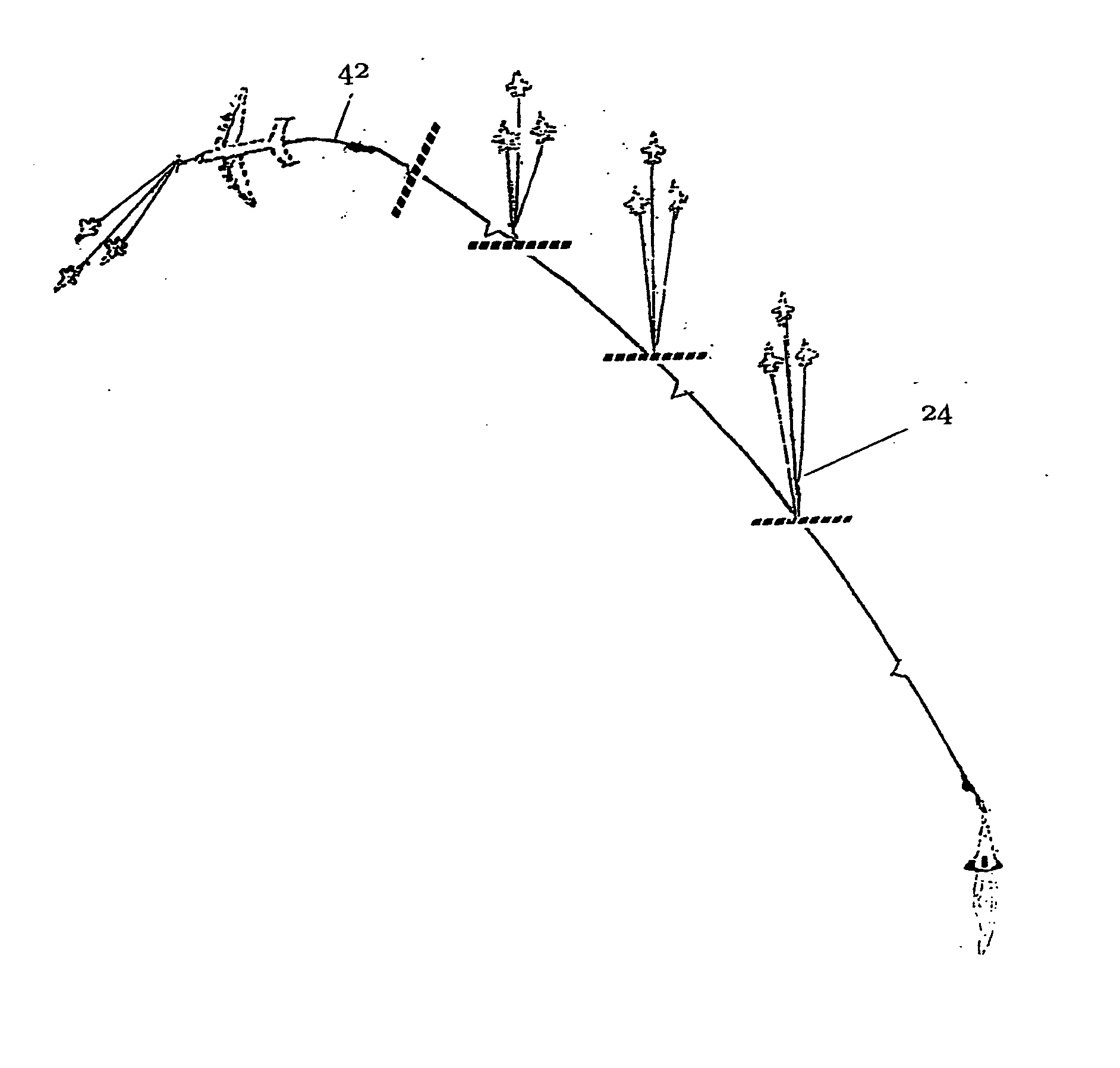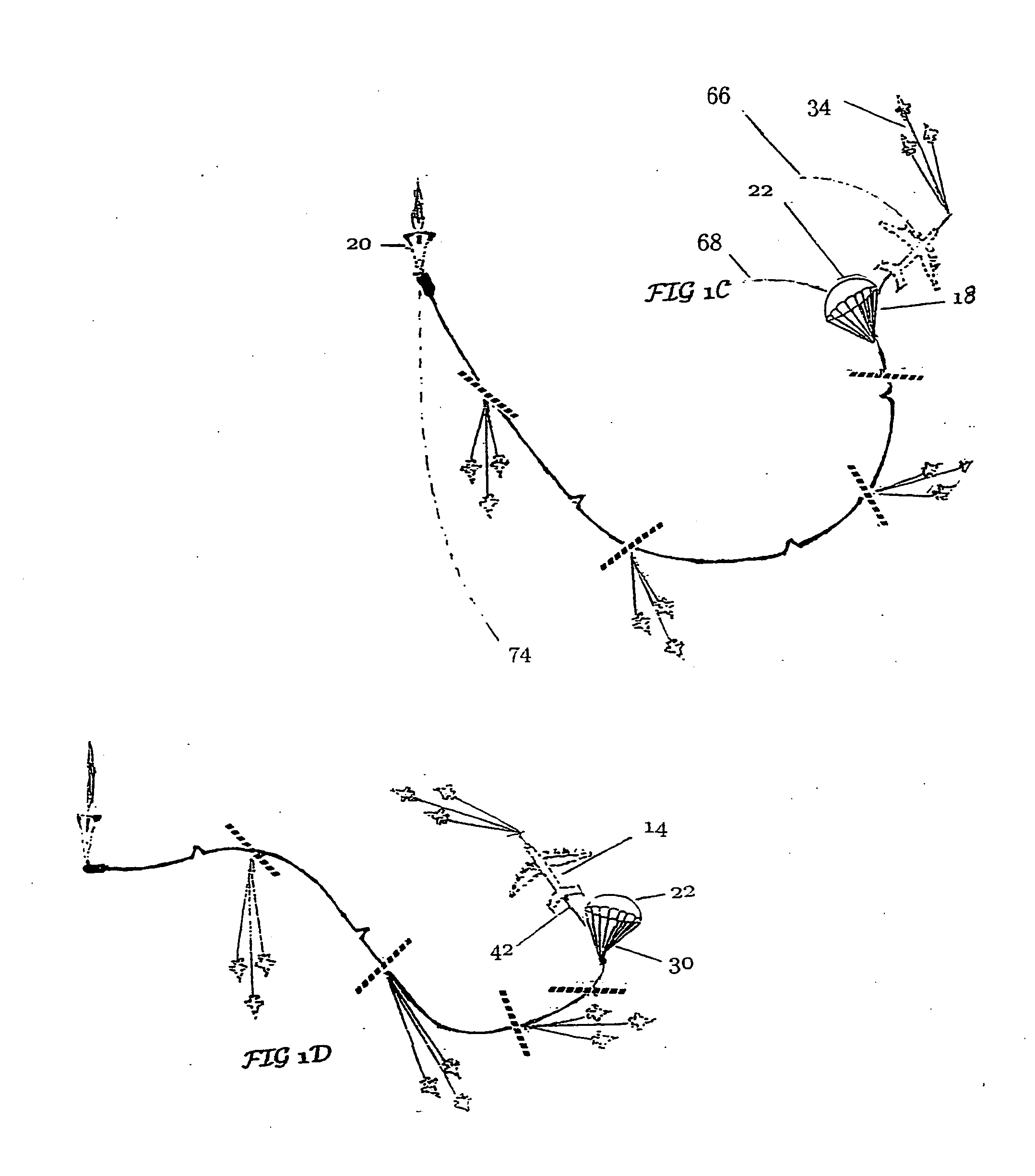Even adjusting the
angle of inclination of the launch would be difficult, as the whole horizontal plane of the circular pathway would have to be tilted to avoid having the
system look like a bent
coin.
As space gets more congested, such a
system obstructs itself after awhile.
Another problem with the
ground level MAGLEV track (one that applies to every scheme that accelerates space vehicles to high velocities while still in the thick of the
atmosphere) is what to do about heat due to aerodynamic friction and about buffeting due to ordinary turbulence.
It is hard to see an
advantage of a ground-based
MAGLEV approach unless it would be powerful enough to fling unassisted a load at least up to a level where the
atmosphere is so thin that
scram jets or rockets reign.
As we all saw in the
space shuttle Columbia disaster, sometimes the problem is simply something being forced or shaken off one part of the launch load by atmospheric resistance and then it runs into a following part.
Spacecraft are often constrained to be extremely rigid, which is why the space shuttles “chatter” so violently during the
high velocity climb-out of the atmosphere and why some parts or accretions will always be prone to come loose.
Kelly claims that turn-around time on the ground will be quite short and, presumably, the turn-around time for the conventional tanker aircraft would also be short so that two launches a day would not be unfeasible.
It is hard to view either the 1997 Kelly concept or the 2000 follow-on as being suitable for manned flight.
This obviously creates a problem for helicopters.
The Piasecki
towing frame and fuel-carrying
glider would at any rate have been a
nightmare paired with a helicopter on the crowded
deck of an aircraft carrier.
To my knowledge, no practical, real use of the system Piasecki describes has ever come about, not even in the odd attempt at endurance flying for the
record books.
One problem that the Hardy system must overcome is the “bounce” that two objects impose on each other when they separate from such
close contact at a high Mach number.
It may not be possible to accurately model every possible contingency and variable in that extreme situation.
The first major
disadvantage of the Clapp scheme is that the Clapp rocketplane will require two separate major fuel systems because it is also a jet plane with two F-16 fighter engines.
Maintaining stasis takes effort.
Whatever the drinking aircraft does, it can't avoid
wasting a percentage of its total fuel use for the flight, as it either has to surrender speed and altitude it just paid to achieve, or it has to carry extra
jet fuel along so that it can keep up with the tanker aircraft as the latter's load lightens and performance improves.
Even in the unlikely situation that safety concerns are waived and ignition is allowed for a throttleable
rocket, the Clapp rocketplane still would have to waste
liquid oxygen and other
rocket fuel as it loafs along at an inefficient pace for a
rocket motor while the delicate fueling process proceeds.
Due to the very high purity requirement for most oxidizers, absolutely no fuel tanks, lines, or valves used for
jet fuel can be utilized for the volatile, cryogenic oxidizers.
Keeping the micro-holes clean is a major challenge.
It may seem counter-intuitive to put a laminar flow suction strip on the bottom of an airfoil, not to mention photo-voltaic cells, but the tow pipeline is a special purpose device that is not going to follow all of the rules.
The tow pipeline is not designed primarily for lift, but extreme speed.
If it should not be all consumed by the instant that the launch load departs, that is not a totally un-useful thing, for the tow pipeline will still need to be cooled down and all the TVC-equipped engines should have a reverse-thrust option which can help the parachutes control
whiplash.
Too small and the system will not accelerate angularly to the maximum potential.
Too large and the tow pipeline may break under tension.
The best stick-and-
throttle airplane jockeys in the world at the moment are probably flying AV-8 Harrier jump jets, which are very quickly crashed by inept pilots.
The reality is that jet engines can operate tens of thousands of hours before needing rebuild, but rocket motors even when recoverable
wear out much more quickly.
The expensive and irreversibly expendable first stage of a conventional rocket like the Saturn V obviously does not pass such a test.
The Hubble space
telescope may be destroyed by 2007 due to the lack of a billion dollars for the manned space mission to fix and supply Hubble.
(b) as mentioned previously, one of the problems with any space launch system that attains high Mach numbers while still in the atmosphere is what happened to the shuttle Columbia.
A fortuitous aspect of the centripetal
reflex design is that anything that shakes loose from any part of the lengthy system will tend to be carried by the
slipstream away from other assemblies.
The potential need for such a seaplane transport in the late 2004 / early 2005 tsunami tragedy in SE Asia became glaringly obvious.
Conventional airplanes could not take desperately needed relief supplies directly to the locations of greatest need.
Crowded conventional airports and devastated ground infrastructure such as roads and bridges cost thousands of lives.
When launching unmanned space vehicles the performance of this method may be significantly increased, for one calculable limitation upon the concept is the necessity of not exceeding accelerations that humans can endure.
It is not inconceivable that some lighter loads could be propelled to escape velocity without rocket assistance by the
reflex method, even also without the optimal existing aircraft posited earlier.
We will presently claim several
peripheral innovations that may be costly to develop, but they are not essential to the good operation of the centripetal
reflex method of space launch.
The cost of developing the very large American tow aircraft of the additional embodiment might be a problem, but it was argued long and hard in (c), (d), and (e) how such an
airplane could justify its development through other uses that would be important to humanity.
The challenge is to create one or several types of multi-purpose aircraft, preferably of very
large size, in an age when most new conceptions are intended as extremely special purpose tools to fit narrow market niches.
 Login to View More
Login to View More  Login to View More
Login to View More 


